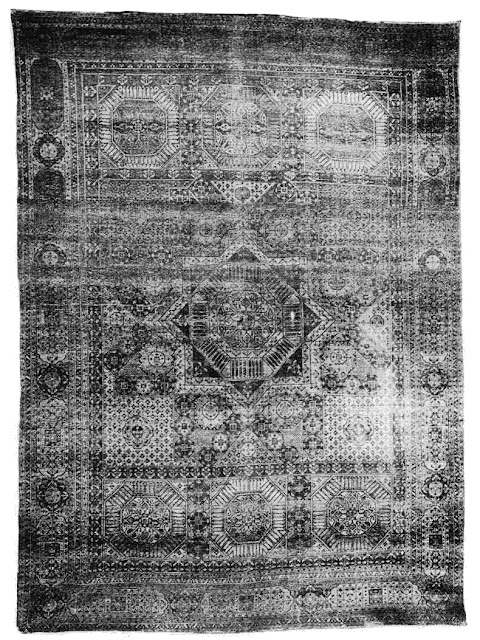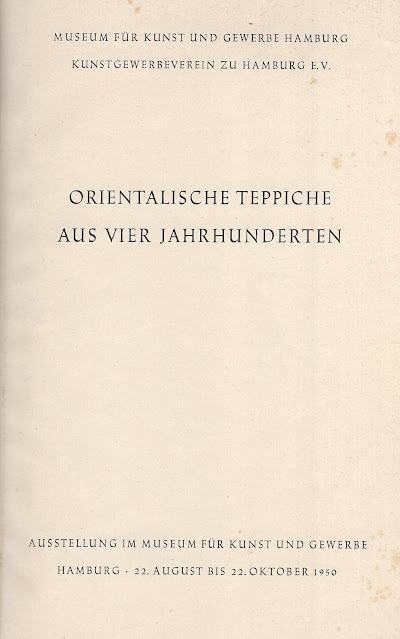Unable to obtain foreign currency in 1936 for a proposed journey to Paris and Lyon, the 35-year old Kurt Erdmann decided instead on a tour of German museums which was to encompass all available carpet depots.He eventually visited 110 collections in 44 cities, with a total inventory of more than 250 items. The Berlin collection, with nearly 200 pieces the largest group, was not included, nor was the Hapsburg collection in Vienna (Erdmann’s article was published in 1942, when Austria had already been annexed)
This stood him in good stead as curator for the 1950 show at the Museum für Kunst & Gewerbe in Hamburg (MKG). Together with Eric Meyer and P.W Meister he assembled a 160-piece show which aimed to inventorize and display the remaining rug treasures in Germanys' war-torn museum landscape. Berlin, which had lost 20 great carpets , was not included in the show as the pieces were still stored in Kaiserroda. A further 17 items had been purloined and were never seen again, thus inflicting a fatal blow to Berlin’s world-renowned collection.
A real highlight was the participation of Otto Bernheimer. Having survived the war in Venezuela, he contributed 47 items in a deft act of product placement. Other probable contributors were the dealer F.K.A Hülsmann from Hamburg; a number of carpets featured in the show, which were later sold at the legendary Dörling auction in 1985, have been attributed to him.Anonymous donors were simply listed as “Private Collection,Hamburg” or “South German Collection “ The Hamburg Museum itself had few carpets at this time, but this was to change in the coming years. Other Museum contributors were the Ethnographic Museum, the Bavarian National Museum and the Residenz Museum in Munich, the Applied Arts Museum in Frankfurt , and the City Art Collections of Düsseldorf and Köln. A number of interesting historical carpets have never been published; the carpets of North Rhine-Westphalia (NRW) have not been seen since 1951 , when the exhibition was reloaded at the Ryksmuseum. However, it has been possible to retrieve some very interesting pieces, from Cologne and Düsseldorf; in particular two Chessboard carpets, which are published here for the first time in colour(the smaller of the two was published by Martin in 1908, but in monochrome)
49 carpets were reproduced in the catalogue; the others have either been identified or their near-equivalents are shown for comparison. Many of the missing items are of lesser interest, mostly 19th century production included for instructional purposes. Dr.Erdmann’s text shows signs of haste, especially in the reference material.The initial descriptions were written up from photos at Erdmann 's home in Bonn, and he had just eight days in Hamburg with the original carpets in order to correct.Trying to decipher his catalogue entries is sometimes difficult: the author could not figure out what he meant by Egyptian carpets divided into small squares until he realised that for Erdmann the Chessboard carpets were also Egyptian, an opinion not current today. Like many academic experts, he eschews the use of dealer parlance.For instance both Holbein and Lotto carpets are lumped together as Holbeins, because Erdmann had no valid shorthand for the two types-he would have had to invent names for them anyway. He is sometimes impossibly long-winded, but one accepts the text density due to his phenomenal grip on the material.
Alas, not much has happened to the German Museum attitude to oriental carpets. Many of the missing carpets from 1950 are still unavailable in reproduction, and museum staff are often disinterested.
Yet a very good exhibition could be mounted with the carpets kept outside of Berlin. Since re-unification the former East German Museums, Leipzig, Dresden und Halle might also be persuaded to open their portals. Kurt Erdmann wrote in his carpet travelogue: ”More than once along the way I wondered whether it would not be possible to combine these so widely scattered works of art in one exhibition, as few of my colleagues who are especially interested in carpets would have the time to repeat this journey, and in many museums the pieces have disappeared again into the depots”
Erdmann even gave us a title for the exhibition: “Oriental Carpets in German Museums” An attempt was made to mount such an event during the 1993 ICOC in Hamburg, where Friedrich Spuhler and Ursula Lienert curated a show entitled "Classical Oriental carpets from German Museums"A promised catalogue unfortunately never appeared.
 |
| 1 |
 |
| 1a |
1) Purchased by Bernheimer in 1937 from Weissberger in Madrid, this Mamluk carpet is unusual in having no circular or cusped medallions, as most larger examples have, with a virtually identical centre in each.Instead, an eight-pointed star and an octagonal have been used, the former reminiscent of a lost carpet once in Berlin (1a ).This example is of the three colour variety.After a run-through at Weinmüller in 1960, the carpet was eventually sold at the Bernheimer St. Valentine` s day massacre by Christies on 14 February 1996, lot 100, for $375,000.With Moshe Tabibnia, Milan. 228 x 485 cm.
 |
| 2 |
2) An unusual three-medallion and three-colour Mamluk carpet in which a kaleidoscope of design has been funnelled onto an undivided field. Erdmann is quite scathing about this giant of a Mamluk (440 x 780 cms) whose pinched borders give it the look of an Aubusson copy. Kept in the Lenbach-Haus in Munich, this fascinating article is neither appreciated nor cared for by its custodians.
 |
| 3 |
3) No good colour photo is available of this three-colour Mamluk,but monochrome is invariably better when studying such items. Erdmann had initially determined the three-colour rugs to be the earliest, but later came to doubt this. However, such simple formulas tend to become part of rug lore. The colour is said to be close to plate 1. Formerly Basserman-Jordan Collection, now Museum Fünf Kontinente, Munich. 119 x 175 cm.
 |
| 4 |
4) A very pretty Mamluk rug with satellite medallions which later sold at the 1985 Dörling auction in Hamburg for 130,000 DM and entered the Bausback Collection. The exact pair, down to the cogwheel-and-star elems, is in the Louvre 119 x 176 cm.
 |
| 5 |
 |
| 5a |
 |
| 6 |
6) Quite effortlessly, a large heap of leaves has settled on a carpet whose borders are only delineated by two narrow stripes.The leaves conglomerate and form a medallion; further nimbi define an infinite repeat somewhat removed from the corners. No Persian rug ever achieved such a gravity-defying stunt, not even Senator Clark’s LaFoes carpet, which in comparison appears leaden-footed-unlike the Cairene carpet from Frankfurt it has a distinct border. Such examples of wall-to wall continue the Mamluk tradition of vanishing borders, albeit with the introduction of a bright yellow. The missing borders later appear in Transylvania. It is an irony that the most elegant of all Turkish rugs were woven in- Egypt. 147 x 190 cm.
 |
| 7 |
 |
| 8 |
7 & 8)) Rising to the challenge of a burgeoning Turkish market, the Cairene weavers adopted the classic Holbein four-and-one medallion design fleshed out with Saz leaves and Lotus palmettes.Two carpets from the legendary NRW collection demonstrate the differing versions ; one is overtly Turkish, with large and powerful medallions.The other has a sequestered medallion design replete with trimmings.The larger style medallions were frequently used for square carpets. 213 x 265 cm & 137 x 198 cm.
 |
9 |
 |
| 9a |
9) A Cairene medallion rug from Bernheimer with a squashed centre, less successful than the Düsseldorf piece (8) Such items were made in two styles, with a medallion decorated either with lotus palmettes or tulips.Those with tulips can sometimes rise to greatness, as in a carpet once with Benguiat and the Wher Collection(9a) The Bernheimer rug sold twice at auction in recent years, first at the Collection sale in 1996 for $ 78,540; and again in 2004 at Christies for $59,225.132 x 191 cm.
 |
| 10 |
10) The superb Dirksen Cairene carpet has interlocking Saz leaves whose basic plan probably influenced the development of the Herati design.The carpet was shown at the 1910 Munich show, and sold for 482,500 GBP at Christies London in 2014. 272 x 242 cm.
 |
| 11 |
 |
| 11a |

